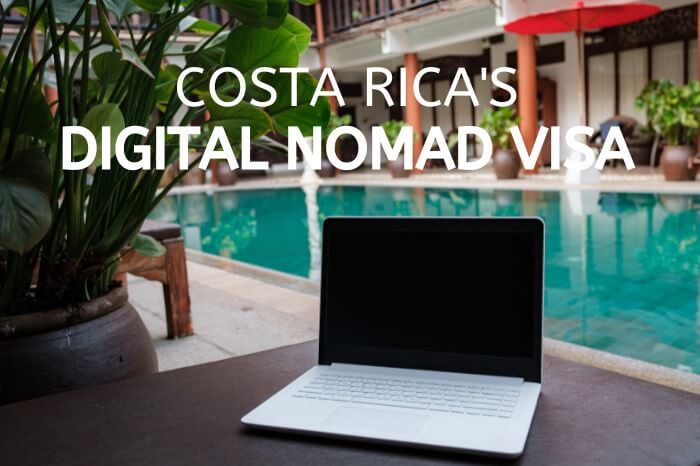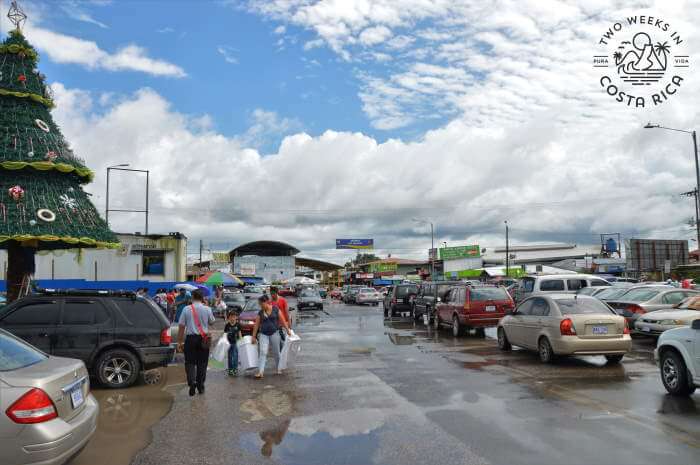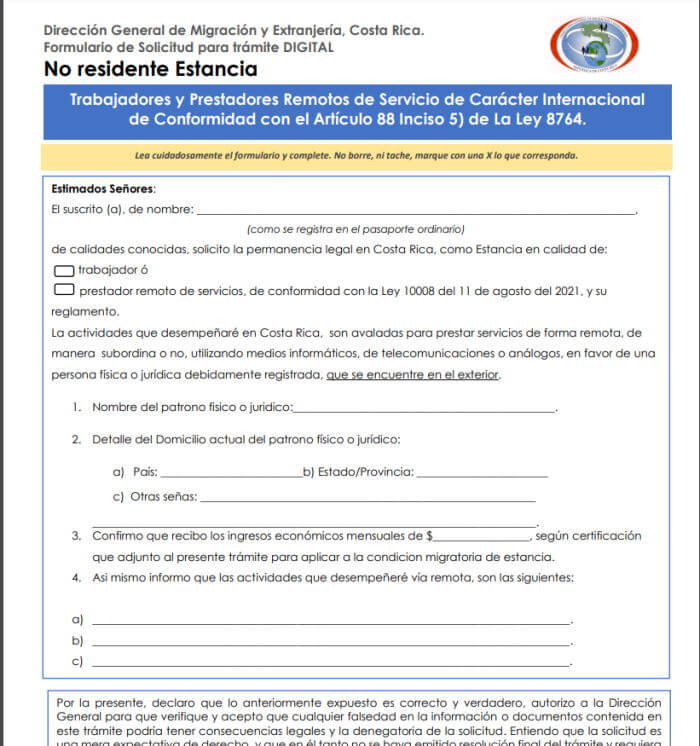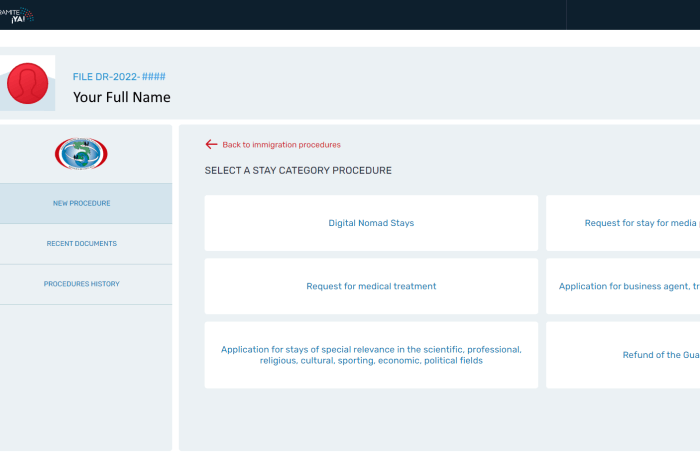Last Updated: June 5, 2024
Since COVID, Costa Rica has seen a surge in digital nomads. More and more people are working remotely, making it the perfect time to try something new. But how does someone go about spending a year or two in Costa Rica? Getting legal residency has always been a challenge, but now, there is another option. In this post, we’ll tell you about Costa Rica’s digital nomad visa. We’ll explain the benefits and requirements, and also give some tips on if it makes sense for you.

Background – Visa Options
Tourist Visas
When a visitor comes to Costa Rica, they are typically given a tourist visa. The exact number of days is up to the discretion of the immigration official, but it is usually 180 days. Note that previously, there was a 90-day visa, but in 2024, the Costa Rican government extended the standard tourist to 180 days.
After a visa expires, they need to leave the country to get additional time. Upon reentry, they will get a new visa, again, usually for 180 days.
Costa Rica has many so-called perpetual tourists who do visa runs every 180 days. They leave Costa Rica when their visa expires, go on a short visit to a neighboring country like Panama or Nicaragua, and come back to Costa Rica to get a new visa. Some have been doing this for years. But the process is not always smooth and can get expensive.

Residency
Getting legal residency is a way to avoid this hassle, but it is not for everyone.
Costa Rica has limited categories of residency. These include pensionado, for those who are retired. Inversionista, for those investing at least $200,000 in property or a business. And rentista, for those still working who deposit $2,500 into a Costa Rican bank account each month.
You also can get residency through marriage to a Costa Rican or by having a direct family relationship (first degree) to a Costa Rican. We have permanent residency, which we got through the birth of our children.
Not only do these categories not work for everyone, but once your residency is approved, you also need to pay into Costa Rica’s socialized health care and retirement system called the Caja or CCSS. For some residency categories, like rentista, this can be quite costly.
In addition, the residency process itself is expensive and time consuming.
For those who are not sure they want to stay in Costa Rica forever, it may not be worth it.
The digital nomad visa fills this gap for people who want to stay longer than a typical tourist but aren’t ready to apply for full residency.
Digital Nomad Visa – Overview
The main advantage of the digital nomad visa is that it allows for a one-year stay in Costa Rica.
An approved application gets you that one year, then you are allowed to renew the visa one more time.
After that, you would need to start a residency application using a traditional track like we explained above, or leave the country at the end of the term of your digital nomad visa and reenter on a tourist visa.
Eligibility
The main eligibility requirement for the digital nomad visa is proof of $3,000 in income per month for an individual, or $4,000 per month for a family. The income needs to come from outside Costa Rica.
Application Process
Compared to the traditional types of residency in Costa Rica, the application process for the digital nomad visa is fairly straightforward.
Application Requirements
Here are the requirements, as set forth on the Costa Rica Tourism Board’s (ICT) website:
1) Application form (a short form that requests basic personal information)
2) Receipt showing payment of the $100 fee (paid by bank deposit to a specific Costa Rican bank account)
3) Copy of passport photo page and entry stamp
4) For applicants from some countries, a consular or restricted visa (does not apply to the United States, Canada, and many other countries)
5) To establish proof of income, bank statements for the last 12 months along with an affidavit.

Family Applications
For families applying, each family member must submit an application form. (See the Migration site for the forms for spouses, minors, people with disabilities, and senior citizens. These are called “Formulario Solicitud de Estancia Dependientes hijos menores o mayores discapacidad” and “Formulario Solicitud de Estancia Dependientes conyuge pareja hijos solteros adultos mayores”).
Each family member also must establish the familial connection to the applicant. For marriages or civil unions, you’ll need a marriage certificate or declaration of a civil union. For minor children or unmarried children up to the age of 25, a birth certificate. For a dependent with disabilities, a medical opinion that identifies the condition. And for seniors, an affidavit.
This is explained in more detail on the Tourism Board website.
All documents need to be translated to Spanish.
The Tourism Board recommends using an official translator approved by the Costa Rican Ministry of Foreign Affairs. See the list here.
Submitting Documents
Here is some important information about submitting your application.
Direccion General de Migracion y Extranjeria (Migration) has the forms and some information on their website.
You can apply online through the Tramite Ya system or in person at Migration (the main office in La Uruca, San Jose or at a regional office).
For Tramite Ya, you will need to create an account. There is an option for English.
Once you have an account, go to New Procedures, Immigration, then select Stays. The digital nomad visa is considered an estancia or stay. You will then be able to complete the application and upload the supporting documents.

Getting Approval and Final Requirements
Migration will process the applications and is supposed to act on them within 15 days. Keep in mind that there are timing requirements by law for the other residency categories as well, and Migration seldom meets them. So it may take longer than 15 days.
Once Migration has sent a resolution approving your application, there are a few additional steps before it is official. You have three months to complete these.
Once you are ready, make an appointment to go in person to Migration using the Call Center (dial 1311) or by calling Banco de Costa Rica at 800-227-2482.
On the day of your appointment, you’ll need to bring:
1) Receipts showing the payment of additional fees. The amounts will be provided in your resolution. They are supposed to be around $120 plus a security deposit based on your nationality (varies by nationality; this is a fee you pay in case you need to be deported to your home country).
2) Passport (original and valid)
3) Proof of medical insurance. This needs to cover your whole stay (i.e., the full year) and be for at least $50,000. If applying as a family, each person needs a policy. The insurance can be from a Costa Rican company that is authorized by the Office of the Superintendent General of Insurance of Costa Rica. Or you can get an international insurance policy.
One of the government insurer’s, INS, is currently offering nomad insurance.
Benefits of Digital Nomad Visa
The digital nomad law allows the main applicant to import digital items related to their trade (e.g., computers, tablets, camera) without being taxed. Practically speaking, since many people bring things like this into the country with them in their luggage, this is not a huge benefit. However, it could help some people.
Digital nomads also will be able to open bank accounts in Costa Rica and can drive with their foreign driver’s license.
Those under the digital nomad visa will not be subject to Costa Rican income taxes, as their income comes from outside the country.
Practical Issues with Digital Nomad Visa
For those who have already filed for residency (e.g., pensionado, rentista, inversionista) and are still waiting to get approved, you should know that if you apply for the digital nomad visa, your other application will be cancelled. This is why some immigration lawyers are recommending that those who have already filed for residency, continue to wait it out until their application is approved.
The digital nomad visa is only for two years maximum so best for those interested in a short stay in Costa Rica.
Conclusion
The digital nomad visa definitely offers an easier way for people to come live in Costa Rica while working remotely. While a lot remains unknown about how the program will go, we hope that many people will be able to take advantage of it.
The information in this post is provided for informational purposes only and is not intended to be legal advice. While we have tried to ensure that the content is accurate and current, we make no guarantees. You should seek legal or other professional advice before acting or relying on any of the information.
Have a question about Costa Rica’s digital nomad visa? Ask us below.
Last Updated: June 5, 2024
Looking for more information about living in Costa Rica? Check out these posts:
Planning a Long-Term Visit to Costa Rica – Get information on where to stay, how to find a rental, transportation, and more.
Moving to Costa Rica with Kids – Covers special considerations of living long-term in Costa Rica with kids, like schools, where to live, and medical care.
Applying for Residency in Costa Rica Without a Lawyer: Thinking a longer stay may be better for you? This article gives an overview of the traditional residency process.
